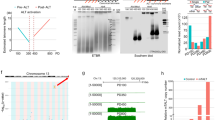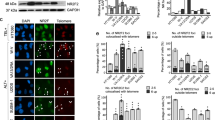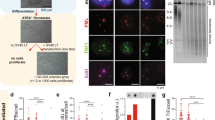Abstract
Ectopic expression of telomerase in telomerase-silent cells is sufficient to overcome senescence and to extend cellular lifespan. We show here that the catalytic subunit of human telomerase (hTERT) crosslinks telomeres. This interaction is blocked by the telomere repeat binding factor 1, but not by a dominant negative form of this protein. It is also abolished by destruction of the RNA component of telomerase as well as by mutations in the hTERT protein. Ectopic expression of hTERT leads to transcriptional alterations of a subset of genes and changes in the interaction of the telomeres with the nuclear matrix. This is associated with reduction of spontaneous chromosome damage in G1 cells, enhancement of the kinetics of DNA repair and an increase in NTP levels. The effect on DNA repair is likely indirect as TERT does not directly affect DNA end rejoining in vitro or meiotic recombination in vivo. The observed effects of hTERT occurred rapidly before any significant lengthening of telomeres was observed. Our findings establish an intimate relationship between hTERT–telomere interactions and alteration in transcription of a subset of genes that may lead to increased genomic stability and enhanced repair of genetic damage. These novel functions of telomerase are distinct from its known effect on telomere length and have potentially important biological consequences.
This is a preview of subscription content, access via your institution
Access options
Subscribe to this journal
Receive 50 print issues and online access
$259.00 per year
only $5.18 per issue
Buy this article
- Purchase on Springer Link
- Instant access to full article PDF
Prices may be subject to local taxes which are calculated during checkout









Similar content being viewed by others
References
Allsopp RC, Vaziri H, Patterson C, Goldstein S, Younglai EV, Futcher AB, Greider CW and Harley CB . (1992). Proc. Natl. Acad. Sci. USA, 89, 10 114–10 118.
Baur JA, Zou Y, Shay JW and Wright WE . (2001). Science, 292, 2075–2077.
Blackburn EH . (2001). Cell, 106, 661–673.
Bodnar AG, Ouellette M, Frolkis M, Holt SE, Chiu CP, Morin GB, Harley CB, Shay JW, Lichtsteiner S and Wright WE . (1998). Science, 279, 349–352.
Braunstein M, Rose AB, Holmes SG, Allis CD and Broach JR . (1993). Genes Dev., 7, 592–604.
Chan SW and Blackburn EH . (2002). Oncogene, 21, 553–563.
Choi D, Whittier PS, Oshima J and Funk WD . (1997). FASEB J., 15, 1014–1020.
Constantinou A, Davies AA and West SC . (2001). Cell. 104, 259–268.
Counter CM, Avilion AA, LeFeuvre CE, Stewart NG, Greider CW, Harley CB and Bacchetti S . (1992). EMBO J., 11, 1921–1929.
de Lange T . (2002). Oncogene, 21, 532–540.
Dhar S, Squire JA, Hande MP, Wellinger RJ and Pandita TK . (2000). Mol. Cell. Biol., 20, 7764–7772.
Etheridge KT, Banik SSR, Armbruster BN, Zhy Y, Terns RM, Terns MP and Counter CM . (2002). J. Biol. Chem., 277, 24764–24770.
Fan Z, Chakravarty P, Alfieri A, Pandita TK, Vikram B and Guha C . (2000). Cancer Gene Ther., 7, 1307–1314.
Feng J, Funk WD, Wang SS, Weinrich SL, Avilion AA, Chiu CP, Adams RR, Chang E, Allsopp RC, Yu J et al. (1995). Science, 269, 1236–1241.
Ford PP, Suh JM, Wright WE and Shay JW . (2000). Mol. Cell Biol., 20, 9084–9091.
Fu W, Killen M, Culmsee C, Dhar S, Pandita TK and Mattson MP . (2000). J. Mol. Neurosci., 14, 3–15.
Gottschling DE, Aparicio OM, Billington BL and Zakian VA . (1990). Cell, 63, 751–762.
Goytisolo FA, Samper E, Martin-Caballero J ., Finnon P, Herrera E ., Flores JM, Bouffler SD and Blasco MA . (2000). J. Exp. Med., 192, 1625–1636.
Hastie ND, Dempster M, Dunlop MG, Thompson AM, Green DK and Allshire RC . (1990). Nature, 346, 866–868.
Hemann MT, Strong MA, Hao LY and Greider CW . (2001). Cell, 107, 67–77.
Hsu HL, Gilley D, Blackburn EH and Chen DJ . (1999). Proc. Natl. Acad. Sci. USA, 96, 12 454–12 458.
Iliakis G, Wang Y and Wang HY . (1999). Methods Mol. Biol., 113, 543–553.
Johnson RT and Rao PN . (1970). Nature, 226, 717–722.
Kawakaim Y, Kitamoto M, Nakanishi T, Yasui W, Tahara E, Nakayama J, Ishikawa F, Tahara H, Ide T and Kajiyama G . (2000). Oncogene, 19, 3888–3893.
Kharbanda S, Kumar V, Dhar S, Pandey P, Chen C, Majumder P, Yuan ZM, Whang Y, Strauss W, Pandita TK, Weaver D and Kufe D . (2000). Curr. Biol., 10, 568–575.
Kondo S, Kondo Y, Li G, Silverman RH and Cowell JK . (1998). Oncogene, 16, 3323–3330.
Krude T and Keller C . (2001). Cell Mol. Life Sci., 58, 665–672.
Kyrion G, Liu K, Liu C and Lustig AJ . (1993). Genes Dev. 7, 1146–1159.
Levy MZ, Allsopp RC, Futcher AB, Greider CW and Harley CB . (1992). J. Mol. Biol., 225, 951–960.
Liu Y, Snow BE, Hande MP, Yeung D, Erdmann NJ, Wakeham A, Itie A, Siderovski DP, Lansdorp PM, Robinson MO and Harrington L . (2000). Curr. Biol., 10, 1459–1462.
Luderus ME, van Steensel B, Chong L, Sibon OC, Cremers FF and de Lange T . (1996). J. Cell Biol., 135, 867–881.
Martin-Rivera L, Herrera E, Albar JP and Blasco MA . (1998). Proc. Natl. Acad. Sci. USA, 95, 10 471–10 476.
Ng P, Cummings DT, Evelegh CM and Graham FL . (2000). Biotechniques, 29, 524–526.
Nishikawa K, Rosenblum MG, Newman RA, Pandita TK, Hittelman WN and Donato NJ . (1992). Cancer Res., 52, 4758–4765.
Olovnikov AM . (1992). Izv. Akad. Nauk Ser. Biol., 4, 641–643.
Ouellette MM, McDaniel LD, Wright WE, Shay JW and Schultz RA . (2000). Hum. Mol. Genet., 9, 403–411.
Pandita TK . (2002). Oncogene, 21, 611–618.
Pandita TK and Hittelman WN . (1992). Radiat. Res., 130, 94–103.
Pandita TK, Gregoire V, Dhingra K and Hittelman WN . (1994). Cytogenet. Cell. Genet., 67, 94–101.
Pandita TK, Pathak S and Geard CR . (1995). Cytogenet. Cell Genet., 71, 86–93.
Pandita TK, Westphal CH, Anger M, Sawant SG, Geard CR, Pandita RK and Scherthan H . (1999). Mol. Cell Biol., 19, 5096–5105.
Plunkett W, Hug V, Keating MJ and Chubb S . (1980). Cancer Res., 40, 588–591.
Pommier Y, Schwartz RE, Zwelling LA and Kohn KW . (1985). Biochemistry, 24, 6406–6410.
Renauld H, Aparicio OM, Zierath PD, Billington BL, Chhablani SK and Gottschling DE . (1993). Genes Dev., 7, 1133–1145.
Roberts JJ . (1978). Adv. Radiat. Biol., 7, 211–435.
Rodriguez Jr CO, Plunkett W, Paff MT, Du M, Nowak B, Ramakrishna P, Keating MJ and Gandhi V . (2000). J. Chromatogr. B. Biomed. Sci. Appl., 745, 421–430.
Rudd GN, Hartley JA and Souhami RL . (1995). Cancer Chemother. Pharmacol., 35, 323–326.
Sawant SG, Gregoire V, Dhar S, Umbricht CB, Cvilic S, Sukumar S and Pandita TK . (1999). FASEB J., 13, 1047–1054.
Scherthan H . (2001). Nat. Rev. Mol. Cell Biol., 2, 621–627.
Scherthan H, Jerratsch M, Dhar S, Wang YA, Goff SP and Pandita TK . (2000). Mol. Cell Biol., 20, 7773–7783.
Sherman PA and Fyfe JA . (1989). Anal. Biochem., 180, 222–226.
Smilenov LB, Dhar S and Pandita TK . (1999). Mol. Cell Biol., 19, 6963–6971.
Smith S and de Lange T . (1997). Trends Genet., 13, 21–26.
Steinert S, Shay JW and Wright WE . (2000). Biochem. Biophys. Res. Commun., 273, 1095–1098.
Struhl K . (1998). Genes Dev., 12, 599–606.
Tahara H, Yasui W, Tahara E, Fujimoto J, Ito K, Tamai K, Nakayama J, Ishikawa F, Tahara E and Ide T . (1999). Oncogene, 18, 1561–1567.
Vafa O, Wade M, Kern S, Beeche M, Pandita TK, Hampton GM and Wahl GM . (2002). Mol. Cell, 9, 1031–1044.
Van Komen S, Petukhova G, Sigurdsson S, Stratton S and Sung P . (2000). Mol. Cell, 6, 563–572.
Vaziri H and Benchimol S . (1998). Curr. Biol., 8, 279–282.
Vaziri H, Squire JA, Pandita TK, Bradley G, Kuba RM, Zhang H, Gulyas S, Hill RP, Nolan GP and Benchimol S . (1999). Mol. Cell Biol., 19, 2373–2379.
Vaziri H, West MD, Allsopp RC, Davison TS, Wu YS, Arrowsmith CH, Poirier GG and Benchimol S . (1997). EMBO J., 16, 6018–6033.
Vaziri H, Dragowska W, Allsopp RC, Thomas TE, Harley CB and Lansdorp PM . (1994). Proc. Natl. Acad. Sci. USA, 91, 9857–9860.
Weinrich SL, Pruzan R, Ma L, Ouellette M, Tesmer VM, Holt SE, Bodnar AG, Lichtsteiner S, Kim NW, Trager JB, Taylor RD, Carlos R, Andrews WH, Wright WE, Shay JW, Harley CB and Morin GB . (1997). Nat. Genet., 17, 498–502.
Wong KK, Chang S, Weiler SR, Ganesan S, Chaudhuri J, Zhu C, Artandi SE, Rudolph KL, Gottlieb GJ, Chin L, Alt FW and DePinho RA . (2000). Nat. Genet., 26, 85–88.
Wood LD, Halvorsen TL, Dhar S, Baur JA, Pandita RK, Wright WE, Hande MP, Calaf G, Hei TK, Levine F, Shay JW, Wang JJ and Pandita TK . (2001). Oncogene, 20, 278–288.
Wright WE and Shay JW . (1992). Trends Genet. 8, 193–197.
Zhang X, Mar V, Zhou W, Harrington L and Robinson MO . (1999). Genes Dev. 13, 2388–2399.
Acknowledgements
We thank Drs R Kucheralapati and Y Heyer for microarray facility, and Drs D Thanos and S Mitra for the suggestions on ChIP. We thank Dr Titia de Lange for providing us reagents for this study. Thanks are due to T. Rounsville for making adenovirus constructs. This work was supported by NIH Grant NS34746 and A-T Children's project to TKP, NCI CN-15015 to JWS and CA13696 to CSHY.
Author information
Authors and Affiliations
Corresponding author
Rights and permissions
About this article
Cite this article
Sharma, G., Gupta, A., Wang, H. et al. hTERT associates with human telomeres and enhances genomic stability and DNA repair. Oncogene 22, 131–146 (2003). https://doi.org/10.1038/sj.onc.1206063
Received:
Revised:
Accepted:
Published:
Issue Date:
DOI: https://doi.org/10.1038/sj.onc.1206063



